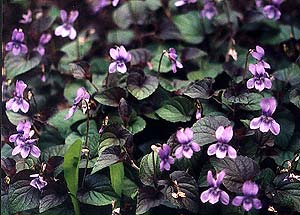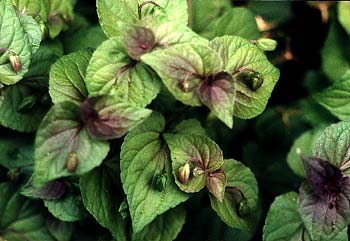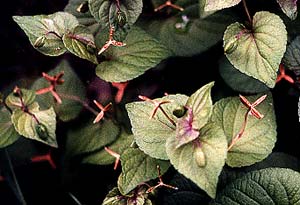
Labrador Violet
Listening, frightened, pale, & cold,
Through the withered leaves & mould
Peered a violet all in dread -
"Where, oh, where is spring?" she said.
-Oliver Herford
(1863-1935)
(1863-1935)
We planted Labradore or Alpine violets (Viola labradorica purpurea) in a moderately shady area of the shade garden, where they soon spread into a fluffy groundcover which was already in full bloom in March (with a few blooms as early as January).
Whether or not in bloom, almost year-round, the leaves or gorgeous. Autumn through much of winter, the leaves are purplish with green blush. In the summer, the leaves are green with purplish blush.
 The blooms persist most heavily into early summer, then it calms down when summer is hottest, but has another thrilling burst of blossom in Autumn.
The blooms persist most heavily into early summer, then it calms down when summer is hottest, but has another thrilling burst of blossom in Autumn.But this pleasing groundcover is far from quiescent even on the hottest days when not in flower. It is busily ripening its charming seeds, which rest atop each of the leaves quite decoratively with the same two-tone shades as the leaves. An early July photo shows this effect. Later in July the seeds burst open into three-pointed stars, as can be seen in the last photo. The emptied seed-husk remains decorative into August.
 In our garden it has proven to be very nearly evergreen, though that hadn't been a promised feature. It gets tatty-looking toward the end of winter, but snatching the homely bits with the fingertips & plucking them rapidly thins the patch & causes it to grow back quickly all refreshed. With a particularly cold winter, they look very tatty indeed near winter's end & require a a more complete shearing, but regrow so rapidly their presence seems scarcely interupted
In our garden it has proven to be very nearly evergreen, though that hadn't been a promised feature. It gets tatty-looking toward the end of winter, but snatching the homely bits with the fingertips & plucking them rapidly thins the patch & causes it to grow back quickly all refreshed. With a particularly cold winter, they look very tatty indeed near winter's end & require a a more complete shearing, but regrow so rapidly their presence seems scarcely interuptedThis species is native to damp woodlands of the northeast of the United States, Labradore, Nova Scotia, & Greenland, hence is cold hardy to a very great degree, but will not thrive in warmer zones.
In conditions that suit it, it can be aggressive enough to displace equally short groundcovers, out-competing anything that is only two or three inches tall. Some gardeners do regard it as invasive, but anything that rises above its level is not threatened by it, so it is excellent under large ferns or under rhododendrons or camellias.
Because of its invasive potential, for the first couple of years I would trim it back before it was full of summer seeds, but eventually I got tired of doing that, so it did seed itself into areas quite distant from where it was originally planted.
So to say the least, it naturalizes easily, & I tend to pull it up as a weed when it pops up at any distance from the area provided for it. It is adaptable to most levels of sunlight, but its ground should never be permitted to dry out quite completely nor become too hard from compaction.